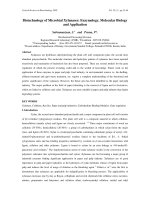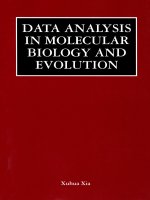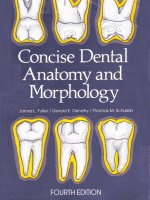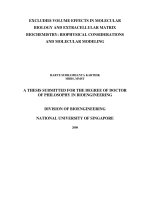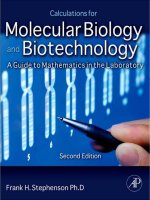Molecular biology and biotechnology 4th ed j walker (RSC, 2000)
Bạn đang xem bản rút gọn của tài liệu. Xem và tải ngay bản đầy đủ của tài liệu tại đây (37.24 MB, 592 trang )
Molecular Biology and Biotechnology
Fourth Edition
This book is dedicated to the memory of
Christopher J. Dean
who died shortly after producing his chapter for this volume.
Molecular Biology and
Biotechnology
Fourth Edition
Edited by
John M. Walker and Ralph Rapley
University of Hertfordshire, Hatfield, UK
RSmC
ROYAL SOCIETY OF CHEMISTRY
ISBN 0-85404-606-2
A catalogue record for this book is available from the British Library
0The Royal Society of Chemistry 2000
Reprinted 2002
All rights reserved
Apart from uny fair dealing for the purposes o j research or private study, or criticism or
review us permitted under the terms of the U K Copyright, Designs und Patents Act, 1988,
this publication muy not be reproduced, stored or transmitted, in any form or by any means,
without the prior permission in writing of The Royul Society of Chemistry, or in the case of
reprogruphic reproduction only in accordance with the terms of the licences issued by the
Copyright Licensing Agency in the UK, or in accordance with the terms of’the licences
issued by the appropriate Reproduction Rights Organization outside the UK. Enquiries
concerning reproduction outside the terms stated here should be sent to The Royal Society
of Chemistry at the address printedon thispuge.
Published by The Royal Society of Chemistry,
Thomas Graham House, Science Park, Milton Road, Cambridge CB4 OWF, U K
Registered Charity Number 207890
For further information see our web site at www.rsc.org
Typeset in Great Britain
Printed in Great Britain by Athenaeum Press Ltd, Gateshead, Tyne and Wear
iv
Preface
One of the exciting aspects of being involved in the field of molecular
biology is the ever accelerating rate of progress, both in the development
of new methodologies and the practical applications of these methodologies. Indeed, such developments led to the idea of the first edition of
Molecular Biology and Biotechnology and subsequent editions have
reflected the fast moving nature of the area. To keep pace with the ever
expanding technological changes we have increased the basic molecular
biology content of the book from one to two chapters in this latest
edition. In recent years the development of the World Wide Web has
been exponential and now provides an essential source of information
and access to databases for the molecular biologist. We therefore
considered it both appropriate and timely to include a new chapter
devoted to the subject of Bioinformatics. Other chapter titles remain the
same as the previous edition but this should not mask the significant
updating of the content of these chapters in response to major developments in each area. Indeed, in order to reflect research developments, the
majority of these chapters have required a total re-write rather than
simple updating.
PCR (only introduced as stand-alone chapter in the last edition) is
firmly established as a day-to-day tool and its revolutionary effect on the
field is evidenced by its inclusion in chapters throughout the book.
Molecular biology continues to profoundly affect progress in areas such
as plant biotechnology, food technology (especially the contentious area
of genetically modified foods), vaccine development, use and application
of monoclonal antibodies, clinical treatment and diagnosis, the production of transgenic plants and animals, and many other areas of research
relevant to the pharmaceutical industry. All these areas have been fully
updated in this edition. In addition, we continue to ensure that biotechnology is not just considered at the gene level and full consideration
continues to be given to aspects of large-scale production and manufacV
vi
Preface
turing with chapters on fermentation technology, downstream processing and the applications of immobilised biocatalysts.
Our continued intention is that this book should primarily have a
teaching function. As such, the book should prove of interest both to
undergraduates studying for biological or chemical qualifications and to
postgraduate and other scientific workers who need a sound introduction
to this ever rapidly expanding area.
John M. Walker
Ralph Rapley
Contents
Chapter 1 Fermentation Technology
Peter F. Stanbury
1 Introduction
2 Microbial Growth
3 Applications of Fermentation
3.1 Microbial Biomass
3.2 Microbial Metabolites
3.3 Microbial Enzymes
3.4 Transformation Processes
3.5 Recombinant Products
4 The Fermentation Process
4.1 The Mode of Operation of Fermentation
Processes
5 The Genetic Improvement of Product Formation
5.1 Mutation
5.2 Recombination
6 Conclusions
Chapter 2 Molecular Analysis and Amplification Techniques
Ralph Rapley
1 Introduction
1.1 Enzymes Used in Molecular Biology
2 Extraction and Separation of Nucleic Acids
2.1 DNA Extraction Techniques
2.2 RNA Extraction Techniques
3 Electrophoresis of Nucleic Acids
4 Restriction Mapping of DNA Fragments
5 Nucleic Acid Blotting and Hybridization
5.1 Hybridization and Stringency
6 Production of Gene Probes
6.1 DNA Gene Probe Labelling
vii
1
1
1
6
6
7
11
11
12
12
13
17
17
20
24
25
25
25
27
27
29
30
32
34
34
31
38
...
Contents
Vlll
7
8
9
10
6.2 Non-radioactive DNA Labelling
6.3 End Labelling of DNA
6.4 Random Primer Labelling of DNA
6.5 Nick Translation labelling of DNA
The Polymerase Chain Reaction
7.1 Stages and Components of the PCR
7.2 Thermostable DNA Polymerases
7.3 Primer Design in the PCR
7.4 PCR Amplification Templates
7.5 Sensitivity of the PCR
7.6 Modifications of the PCR
7.7 Applications of the PCR
Alternative Amplification Techniques
Nucleotide Sequencing of DNA
9.1 Dideoxynucleotide Chain Terminators
9.2 Direct PCR Sequencing
9.3 Cycle Sequencing
9.4 Automated Fluorescent DNA Sequencing
9.5 Maxam and Gilbert Sequencing
Bioinformatics and the Internet
Chapter 3 Recombinant DNA Technology
Ralph Rapley
1 Introduction
2 Constructing Gene Libraries
2.1 Digesting Genomic DNA Molecules
2.2 Ligating DNA Molecules
2.3 Considerations in Gene Library Preparation
2.4 Genomic DNA Libraries
2.5 cDNA Libraries
2.6 Linkers and Adaptors
2.7 Enrichment Methods for RNA
2.8 Subtractive Hybridisation
2.9 Cloning PCR Products
3 Cloning Vectors
3.1 Plasmid Derived Cloning Vectors
3.1.1 Plasmid Selection Systems
3.1.2 pUC Plasmid Cloning Vectors
3.2 Virus-based Cloning Vectors
3.2.1 Insertion and Replacement
Cloning Vectors
3.3 M 13 and Phagemid-based Cloning Vectors
39
40
41
41
42
45
48
48
50
50
52
54
55
57
58
60
61
62
63
64
67
67
68
68
68
71
72
74
75
76
77
77
79
80
81
82
84
86
88
ix
Contents
3.3.1 Cloning into Single-stranded Phage
Vectors
3.4 Cosmid-based Cloning Vectors
3.5 Large Insert Capacity Cloning Vectors
3.6 Yeast Artificial Chromosome (YAC) Cloning
Vectors
Vectors Used in Eukaryotic Cells
Gene Probes and Hybridisation
4.1 Cloned DNA Probes
4.2 RNA Gene Probes
Screening Gene Libraries
5.1 Colony and Plaque Hybridisation
5.2 Gene Library Screening by PCR
5.3 Screening Expression cDNA Libraries
5.4 Hybrid Select/Arrest Translation
Applications of Gene Cloning
6.1 Sequencing Cloned DNA
6.2 In vitro Mutagenesis
6.3 Oligonucleotide-directed Mutagenesis
6.4 PCR-based Mut agenesis
Expression of Foreign Genes
7.1 Production of Fusion Proteins
7.2 Expression in Mammalian Cells
7.3 Display of Proteins on Bacteriophage
Analysing Genes and Gene Expression
8.1 Identifying and analysing mRNA
8.2 Reverse Transcriptase PCR (RT-PCR)
8.3 Analysing Genes in situ
8.4 Transgenics and Gene Targeting
Microarrays and DNA Chips
Analysing Whole Genomes
10.1 Physical Genome Mapping
10.2 Gene Discovery and Localisation
10.3 Human Genome Mapping Project
3.7
4
5
6
7
8
9
10
Chapter 4 The Expression of Foreign DNA in Bacteria
Robert J . Slater and D . Ross Williams
1 Introduction
2 Control of Gene Expression
2.1 Prokaryotes
2.2 Eukaryotes
90
91
93
93
94
95
95
96
96
96
99
99
101
101
101
102
103
103
105
106
109
109
111
111
112
113
115
116
117
118
120
122
125
125
128
128
132
Contents
X
The Expression of Eukaryotic Genes in Bacteria
3.1 Introns
3.2 Promoters
3.3 Ribsome Binding Site
3.4 Expression of Foreign DNA as Fusion
Proteins
3.5 Expression of Native Proteins
Detecting Expression of Foreign Genes
Maximising Expression of Foreign DNA
5.1 Optimising Expression in E. coli
Alternative Host Organisms
Future Prospects
Further Reading
134
135
136
137
Chapter 5 Yeast Cloning and Biotechnology
Brendan P.G. Curran and Virginia C. Bugeja
1 Introduction
2 Gene Manipulation in S . cerevisiae
2.1 Introducing DNA into Yeast
2.2 Yeast Selectable Markers
2.3 Vector Systems
3 Heterologous Protein Production
3.1 The Source of Heterologous DNA
3.2 The Level of Heterologous mRNA Present
in the Cell
3.3 The Amount of Protein Produced
3.4 The Nature of the Required Product
4 Using Yeast to Analyse Genomes, Genes and
Protein-Protein Interactions
4.1 YAC Technology
4.2 Gene Knockouts
4.3 Novel Reporter Systems
5 Future Prospects
155
Chapter 6 Cloning Genes in Mammalian Cell-lines
Edward J . Murray
1 Introduction
2 Methods of DNA Transfection
2.1 Calcium Phosphate Co-precipitation
2.2 DEAE-Dextran
2.3 Electroporation
2.4 Protoplast Fusion
177
3
4
5
6
7
8
138
142
144
145
148
150
153
153
155
155
155
156
156
159
159
159
160
162
164
164
169
172
174
177
179
180
181
182
182
xi
Contents
3
4
5
6
2.5 Lipofection
2.6 Polybrene-DMSO Treatment
2.7 Microinjection
2.8 Scrapefection
Requirements for Gene Expression
The DNA Component
4.1 Use of Vectors
4.2 Plasmid-based Vectors
4.3 Virus-based Vectors
4.4 Adrenovirus Vectors
4.5 Retrovirus Vectors
4.6 Poxviral Vectors
4.7 Baculovirus Vectors
Some Considerations in Choice of Cell-line
Transient versus Stable Expression
6.1 Selection by Host Cell Defect
Complementation
6.2 Dominant Selective Techniques
6.3 Amplifiable Selection Systems
Chapter 7 Plant Biotechnology
Michael G .K . Jones
1 Introduction
2 Applications of Molecular Biology to Speed up
the Processes of Crop Improvement
2.1 Molecular Maps of Crop Plants
2.2 Molecular Markers
2.3 Types of Molecular Markers
2.4 Marker-assisted Selection
2.5 Examples of Marker-assisted Selection
2.6 Molecular Diagnostics
2.7 DNA Fingerprinting, Variety Identification
2.8 DNA Microarrays
2.9 Bioinformatics
3 Transgenic Technologies
3.1 Agrobacterium-mediated Transformation
3.2 Selectable Marker and Reporter Genes
3.3 Particle Bombardment
4 Applications of Transgenic Technologies
5 Engineering Crop Resistance to Herbicides
6 Engineering Resistance to Pests and Diseases
6.1 Insect Resistance
183
184
184
185
185
189
189
189
191
191
192
193
195
196
197
198
198
200
203
203
203
204
205
205
206
208
208
209
210
210
21 1
21 1
21 1
212
213
215
215
215
xii
Contents
6.2 Engineered Resistance to Plant Viruses
6.3 Resistance to Fungal Pathogens
6.4 Natural Resistance Genes
6.5 Engineering Resistance to Fungal Pathogens
6.6 Resistance to Bacterial Pathogens
6.7 Resistance to Nematode Pathogens
7 Manipulating Male Sterility
8 Tolerance to Abiotic Stresses
9 Manipulating Quality
9.1 Prolonging Shelf Life
9.2 Nutritional and Technological Properties
9.2.1 Proteins
9.2.2 Oils
9.2.3 Manipulation of Starch
9.2.4 Fructans
9.3 Manipulation of Metabolic Partitioning
10 Production of Plant Polymers and Biodegradable
Plastics
11 Plants as Bioreactors: Biopharming and
Neu traceu ticals
1 1.1 Edible Vaccines
1 1.2 Production of Antibodies in Plants
1 1.3 Plant Neutraceuticals
12 Plant Biotechnology in Forestry
13 Intellectual Property
14 Public Acceptance
15 Future Prospects
Chapter 8 Molecular, Structural and Chemical Biology in
Pharmaceutical Research
Tomi K . Sawyer
1 Introduction
2 Molecular Biology of Disease and in vivo
Transgenic Models
3 Genomic Protein Targets and Recombinant
Therapeutics
4 Structural Biology and Rational Drug Design
5 Chemical Biology and Molecular Diversity
6 Gene Therapy and DNA/RNA-Targeted
Therapeutics
7 Future Prospects in Pharmaceutical Research
8 Conclusions
217
219
220
222
223
224
225
225
226
227
227
227
228
229
230
230
23 1
232
232
233
233
233
234
235
236
237
237
238
24 1
247
252
257
259
260
Contents
...
Xlll
Chapter 9 Genetically Modified Foods
Rosa K . Pawsey
1 Introduction
2 Legal Requirements in the Production of Novel
Foods and Processes
3 Foodcrops
4 Food Animals
5 Current Trends in Manufactured Foods
6 Consumer Acceptance and Market Forces
261
Chapter 10 Molecular Diagnosis of Inherited Disease
Elizabeth Green
1 Introduction
2 Direct Detection of Gene Mutations
2.1 Detection of Deletions, Duplications and
Insertions
2.2 Expansion Mutations
2.3 Point Mutations
2.3.1 Allele-specific Oligonucleotides
2.3.2 Restriction Enzyme Site Analysis
2.3.3 ‘ARMS’
2.3.4 Oligonucleotide Ligation
2.3.5 Fluorescently Labelled DNA
Sequencing
3 Indirect Diagnosis with Linked Genetic Markers
4 Future Prospects
279
Chapter 11 DNA in Forensic Science
Paul Debenham and Peter D . Martin
1 Introduction
2 MLP and SLP Technology
2.1 MLP/SLP Methods
2.1.1 Extraction and Purification of the DNA
2.1.2 Quantitation
2.1.3 Restriction Endonuclease Digestion of
DNA
2.1.4 Electrophoretic Separation
2.1.5 Hybridization
2.2 Analysis of Results
3 PCR Technology
3.1 The First PCR-based Forensic System
295
26 1
262
265
27 1
272
276
279
280
28 1
283
285
285
286
287
289
290
29 1
292
295
296
299
299
300
300
30 1
30 1
302
302
304
Contents
xiv
4 Short Tandem Repeats
4.1 Method
4.1.1 Extraction of DNA
4.1.2 Quantitation of DNA
4.1.3 Amplification of DNA
4.1.4 Separation of Products
5 Databases
6 Interpretation of the Results
7 Mitochondria1 DNA
8 Y Chromosome Analysis
9 The Future
9.1 Capillary Electrophoresis
9.2 DNA Chip Technology
Chapter 12 Vaccination and Gene Manipulation
Michael Macket t
1 Infectious Disease - The Scale of the Problem
2 Current Vaccination Strategies
2.1 Inactivated Vaccines
2.2 Live Attenuated Vaccines
2.3 The Relative Merits of Live versus Killed
Vaccines
3 The Role of Genetic Engineering in Vaccine
Identification, Analysis and Production
3.1 Identification and Cloning of Antigens with
Vaccine Potential
3.1.1 DNA/Oligonucleotide Hybridization
3.1.2 Hybrid Selection and Cell-free
Translation
3. I .3 Expression Cloning
3.1.4 Genomic Sequencing
3.2 Analysis of Vaccine Antigens
3.2.1 B-cell Epitopes
3.2.2 T-cell Epitopes
3.3 Generation of Subunit Vaccines
3.3.1 Expression of Potential Vaccine
An ti gens
4 Improvement and Generation of New Live
Attenuated Vaccines
4.1 Improving Current Live Attenuated Vaccines
4.1.1 New Vaccines for Pseudorabies Virus
304
305
305
307
307
307
308
310
311
313
313
313
314
317
317
319
319
321
321
323
323
324
324
325
326
327
329
329
330
330
333
333
333
xv
Contents
4.1.2 Improving Attenuation in Vibrio
cholerae
4.1.3 Improving Stability - Poliovirus
4.2 Recombinant Live Vectors
4.2.1 Vaccinia Virus Recombinants
4.2.2 Recombinant BCG Vaccines
4.2.3 Attenuated Salmonella Strains as Live
Bacterial Vaccines
4.2.4 Poliovirus Chimaeras
4.2.5 Cross-species Vaccination, ‘Live-dead’
Vaccines
4.2.6 Other Virus Vectors
4.2.7 Recombinant E. coli Strains
5 Other Approaches to Vaccines
5.1 DNA Vaccines (Genetic Immunisation)
5.1.1 Optimizing Responses
5.1.2 RNA Immunisation
5.2 Peptide Vaccines
5.3 Anti-idiotypes
5.4 Enhancing Immunogenitity and Modifying
Immune Responses
5.4.1 Adjuvants, Carriers and Vehicles
5.4.2 Carriers
5.4.3 Mucosal Immunity
5.4.4 Modulation of Cytokine Profile
5.4.5 Modulation by Antigen Targeting
5.4.6 Modulation of Signalling
6 Summary and Conclusions
7 Further Reading and Sources of Information
Chapter 13 Tr ansgenesis
Linda J. Mullins and John J. Mullins
1 Introduction
2 The Production of Transgenic Animals by Microinjection
2.1 Transgenic Mice
2.2 Transgenic Rats
2.3 Choice of Animal
2.4 Applications of Micro-injection Techniques to
Other Animals
2.5 Animal Cloning
334
336
336
337
338
339
339
340
34 1
34 1
342
342
343
344
345
346
347
347
348
349
349
350
350
350
353
357
357
358
358
360
361
361
362
xvi
Contents
3 Embryo Stem Cell Technology, Homologous
Recombination and Transgenesis
4 General Considerations
4.1 The Construct
4.2 Aberrant Expression
5 Design of the Transgenic Experiment
5.1 Investigating Gene Expression
5.2 Reduction of Gene Function
5.3 Cell Ablation
5.4 Conditional Gene Alteration
5.4.1 Inducible Gene Targeting Using the
Cre-lox System
5.4.2 Tet racycline/Tamoxifen
6 Commercial Applications
6.1 Biopharmaceuticals in Transgenic Animals
6.2 Xenografts
6.3 Toxicological Applications
6.4 Immortomouse
7 Future Prospects
Chapter 14 Protein Engineering
John R. Adair
1 Introduction
1.1 Protein Structures
2 Tools
2.1 Sequence Identification
2.2 Sequence Determination and Modelling
2.3 Sequence Modification
2.3.1 Site-directed Mutagenesis Methods
2.3.1.1 Non-PCR Methods
2.3.1.2 PCR-based Methods
2.4 Molecular Evolution
2.5 de novo Sequence Design
2.6 Expression
2.7 Analysis
3 Applications
3.1 Point Mutations
3.1.1 Betaseron/Betaferon (Interferon /3- 16)
3.1.2 Humalog (Lispro Insulin)
3.1.3 Novel Vaccine Adjuvants
3.2 Domain Shuffling (Linking, Swapping and
Deleting)
363
366
366
368
368
368
369
371
372
372
374
375
375
376
377
377
378
379
379
380
381
38 1
381
382
383
383
385
385
389
389
39 1
392
392
392
393
393
394
xvii
Contents
3.2.1 Linking Domains
3.2.1.1 Domain Fusions for Cell
Targeting
3.2.1.2 Fused Cytokines
3.2.1.3 Fusions to Stabilize Dimeric
Proteins
3.2.2 Swapping Protein Domains
3.2.2.1 Chimaeric Mouse-Human
Antibodies
3.2.2.2 Polyketide Synthases (PJCSs)
3.2.3 Deleting Domains
3.3 Whole Protein Shuffling
3.4 Protein-Ligand Interactions
3.4.1 Enzyme Modifications
3.4.2 Hormone Agonists
3.4.3 Substitution of Binding Specificities
3.5 Towards de novo Design
3.5.1 de novo Design
4 Conclusions and Future Directions
Chapter 15 Bioinformatics
Peter M . Woollard
1 Introduction
2 Databases
2.1 Sequence Databases
2.1.1 Nucleic Acid Sequence Databases
2.1.2 Protein Sequence Databases
2.1.3 Protein Family and Motif Databases
2.2 Genome Databases
2.3 Enzyme Databases
2.4 Literature Databases
2.4.1 Medline
2.4.2 BIDS Embase
2.4.3 BIDS IS1 Citation Indexes and Index to
Scientific and Technical Proceedings
(ISTP)
3 Sequence Analysis
3.1 Sequence Database Searching
3.1.1 Keyword Searching
3.1.2 Database Scanning
3.2 Pairwise and Multiple Sequence Comparisons
and Alignments
'
394
394
395
396
396
396
397
397
397
400
400
40 1
40 1
402
402
404
405
405
408
410
410
412
412
414
414
416
416
416
416
416
417
417
417
420
xviii
Conten t s
4
5
6
7
3.2.1 Pairwise Comparisons
3.2.2 Multiple Sequence Alignments
3.2.3 Improving the Alignment
3.2.4 Profile Searching
3.3 Other Nucleic Acid Sequence Analysis
3.3.1 Gene Identification
3.3.2 Restriction Mapping
3.3-3 Single Nucleo tide Polymorphisms
(SNPs)
Protein Structure
Mapping
5.1 Introduction
5.2 Linkage Analysis
5.3 Physical Mapping
5.4 Radiation Hybrids
5.5 Primer Design
Bioinformatics Sites and Centres
6.1 Local Bioinformatics Services
6.2 National EMBnet Nodes
6.3 Specialized Sites
Conclusion and Future Prospects
Chapter 16 Immobilization of Biocatalysts
Gordon F. Bickerstafl
1 Introduction
2 Biocatalysts
2.1 Enzymes
2.1.1 Specificity
2.1.2 Catalytic Power
2.2 Ri bozymes
2.3 Abzymes
2.4 Multienzyme Complexes
2.4.1 PDC
2.4.2 Proteosome
2.4.3 Cellulosome
2.4.4 Multienzyme Complexes and
Immobilization Technology
2.5 Cells
2.5.1 Animal Cells
2.5.2 Plant Cells
2.5.3 Microorganisms (Bacteria, Yeast and
Filamentous Fungi)
42 1
42 1
425
426
426
426
426
426
427
428
428
428
428
429
429
429
430
430
430
43 1
433
433
433
434
435
436
437
437
439
439
439
440
44 1
442
442
443
443
Contents
XlX
Biocatalyst Selection
3 Immobilization
3.1 Choice of Support Material
3.1.1 Next Generation of Support
Material
3.2 Choice of Immobilization Procedure
3.2.1 Adsorption
3.2.2 Covalent Binding
3.2.3 Entrapment
3.2.4 Encapsulation
3.2.5 Cross-linking
4 Properties of Immobilized Biocatalysts
4.1 Stability
4.2 Catalytic Activity
5 Applications
2.6
Chapter 17 Downstream Processing: Protein Extraction and
Purification
Mike D . Scawen and P.M. Hammond
1 Introduction
2 Cell Disruption
2.1 Enzymic Methods of Cell Disruption
2.2 Chemical Methods of Cell Lysis
2.2.1 Alkali
2.2.2 Detergents
2.3 Physical Methods of Cell Lysis
2.3.1 Osmotic Shock
2.3.2 Grinding with Abrasives
2.3.3 Solid Shear
2.3.4 Liquid Shear
3 Initial Purification
3.1 Debris Removal
3.2 Batch Centrifuges
3.3 Continuous-flow Centrifugation
3.4 Basket Centrifuges
3.5 Membrane Filtration
4 Aqueous Two-phase Separation
5 Precipitation
5.1 Ammonium Sulfate
5.2 Organic Solvents
5.3 High Molecular Weight Polymers
5.4 Heat Precipitation
444
444
446
448
448
448
450
453
454
455
456
456
457
460
461
46 I
462
463
463
463
464
464
464
464
465
465
466
466
467
467
468
468
469
47 1
47 1
47 1
472
472
xx
Contents
6 Chromatography
6.1 Scale-up and Quality Management
6.2 Method Selection
6.3 Selection of Matrix
6.4 Gel Filtration
6.5 Ion Exchange Chromatography
6.6 Affinity Chromatography
6.7 Hydrophobic Interaction Chromatography
6.8 High Performance Chromatographic
Techniques
6.9 Perfusion Chromatography
6.10 Expanded Bed Adsorption
6.1 1 Membrane Chromatography
6.12 Maintenance of Column Packing Materials
6.13 Equipment for Large-scale Chromatography
6.14 Control and Automation
7 Ultrafiltration
8 Design of Proteins for Purification
8.1 Inclusion Bodies
8.2 Affinity Tails
9 Future Trends
Chapter 18 Monoclonal Antibodies
Christopher J. Dean
1 Introduction
2 Antibody Structure
3 Preparation of Hybridomas by Somatic Cell Fusion
3.1 Principle of the Technology
3.2 Choice of Myeloma Cell-line
3.3 Choice of Host for Production of Immune
B-cells
3.4 Immunogen and Route of Immunization
3.5 Preparation of Myeloma Cell-line and Host
Immune Lymphocytes for Fusion
3.6 Hybridoma Formation by Somatic Cell
Fusion
3.7 Screening Hybridoma Culture Supernatants
3.8 Cloning Hybridomas
3.9 Bulk Production, Isolation and Purification
of Monoclonal Antibodies
3.9.1 Bulk Production
3.9.2 Isolation and Purification
472
472
475
475
479
480
48 1
484
485
486
487
488
488
489
49 1
49 1
492
492
492
496
497
497
498
499
499
500
50 1
502
503
504
504
506
506
506
507
xxi
Contents
Examples of the Preparation of Rat Monoclonal
Antibodies Which Have Been Used to Investigate
the Structural and Functional Properties of
Macromolecules
4.1 HIV I gp120
4.2 mAbs to Growth Factor Receptors
4.3 Monoclonal Antibodies for Clinical
Application
5 Generation of Monclonal Antibodies Using
Recombinant Gene Technology
5.1 Isolation of Immunoglobulin Variable Region
Genes and Expression on the Surface of
Bacteriophage
5.1.1 Isolation of mRNA for V H and VL and
Generation of cDNA
5.1.2 PCR Amplification of cDNAs for
Antibody VH and VL
5.1.3 Linking of VH and VL to Give scFv
5.1.4 Insertion of scFv into Phagemid Vector
5.1.5 Expression of scFv on the Surface of
Bacteriophage
5.1.6 Screening Phage Display Libraries of
Immunoglobulin Genes
5.1.7 Preparation of Soluble scFv
5.1.8 Screening Supernatants Containing
Soluble scFv
6 Monoclonal Antibodies in Biomedical Research
7 Monoclonal Antibodies in the Diagnosis and
Treatment of Disease
4
Chapter 19 Biosensors
Martin F. Chaplin
1 Introduction
2 The Biological Reaction
3 Theory
4 Electrochemical Methods
4.1 Amperometric Biosensors
4.2 Potentiometric Biosensors
4.3 Conductimetric Biosensors
5 Calorimetric Biosensors
6 Piezoelectric Biosensors
508
508
509
51 1
512
512
513
514
515
515
516
516
517
517
517
519
521
52 1
526
527
530
530
539
54 1
542
544
Contents
xxii
7 Optical Biosensors
7.1 Evanescent Wave Biosensors
7.2 Surface Plasmon Resonance
8 Whole Cell Biosensors
9 Immunosensors
10 Conclusion
Subject Index
545
548
550
551
552
554
555
Contributors
J.R. Adair, Cambridge, U K
G.F. Bickerstaff, Department of Biological Sciences, University of Paisley,
Paisley PA1 2BE, UK
V.C. Bugeja, Department of Biosciences, University of Hertfordshire,
College Lane, Hatfield, Her fordshire ALlO 9AB, UK
M.F. Chaplin, School of Applied Science, South Bank University, 103
Borough Road, London S E l OAA, U K
B.P.G. Curran, School of Biological Sciences, Queen Mary and Westfield
College, University of London, Mile End Road, London E l 4NS, UK
P. Debenham, University Diagnostics, South Bank Technopark, 90
London Road, London S E l 6 L N , U K
C.J. Dean, formerly of McElwain Laboratories, Institute of Cancer
Research, U K
E. Green, South Thames Regional Genetics Centre, Division of Medical
and Molecular Genetics, Guys Hospital, St Thomas Street, London SEI
9RT, U K
P.M. Hammond, Centre for Applied Microbiology and Research, Porton
Down, Salisbury, Wiltshire SP4 OJG, UK
M.G.K. Jones, Western Australian State Agricultural Biotechnology
Centre, Murdoch University, Loneragan Building, Perth 6150, Western
Australia
M. Mackett, CRC Department of Molecular Biology, Molecular Genetics
Section, Paterson Institute of Cancer Research, Christie Hospital N H S
Trust, Manchester M20 9BX, UK
P.D. Martin, University Diagnostics, South Bank Technopark, 90 London
Road, London S E l 6 L N , U K
J.J. Mullins, The Molecular Physiology Laboratory, The Wilkie Building,
University of Edinburgh Medical School, Teviot Place, Edinburgh
EH8 9AG, U K
XXlll
